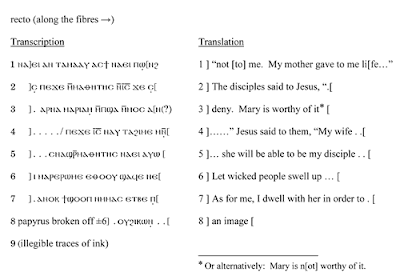(from huffingtonpost.com
by Jaweed Kaleem)
An ancient, business-card-sized papyrus fragment that appears to quote Jesus Christ discussing his wife is real, Harvard University announced Thursday. The fragment caused international uproar when it was revealed by a Harvard historian in September 2012, with prominent academics and the Vatican swiftly deeming it a forgery.
Harvard officials said scientists both within and outside the university extensively tested the papyrus and carbon ink of the badly aged fragment, dubbed the "Gospel of Jesus' Wife." The document, written in Coptic, a language of ancient Egyptian Christians, is made up of eight mostly legible dark lines on the front and six barely legible faded lines on the back. The handwriting and grammar were also examined over the last year and a half to confirm its authenticity. Scientists have concluded the fragment dates back to at least the sixth to ninth centuries, and possibly as far back as the fourth century.
The document was never meant to prove Jesus was married, Harvard Divinity School professor Karen L. King emphasized Thursday. Instead, she argued, it's meant to highlight that some early Christians may have believed Jesus was married. The distinction is significant because debates over sexuality and marriage have dominated contemporary discussions about Christianity; the Catholic Church cites Jesus' celibacy as one reason its priests must not have sex or marry.
"The main topic of the fragment is to affirm that women who are mothers and wives can be disciples of Jesus -- a topic that was hotly debated in early Christianity as celibate virginity increasingly became highly valued," King, whose specialties include Coptic literature, Gnosticism and women in the Bible, said in a statement Thursday. "This gospel fragment provides a reason to reconsider what we thought we knew by asking what the role claims of Jesus' marital status played historically in early Christian controversies over marriage, celibacy, and family."
The legible lines on the front of the artifact seem to form a broken conversation between Jesus and his disciples. The fourth line of the text says, "Jesus said to them, my wife." Line 5 says "... she will be able to be my disciple," while the line before the "wife" quote has Jesus saying "Mary is worthy of it" and line 7 says, “As for me, I dwell with her in order to ..."
Front of fragment with translation
Back of fragment with translation
King first announced the existence of the fragment on Sept. 18, 2012, at the International Coptic Congress in Rome. But after looking at photos of the fragment and a draft of a related paper that was scheduled to be published in the Harvard Theological Review, scholars quickly began to doubt the findings. Some said the handwriting, grammar, shape of the papyrus and the ink's color and quality made it suspect. Others said the ink and papyrus should have been chemically dated before being publicly announced. The fact that the fragment's owner, identified as German donor who bought the piece in 1999 from a collector who had owned it since 1960s, was anonymous, also attracted suspicion.
The Harvard Theological Review decided not to publish King's paper until further testing and analysis, which included electrical engineering, chemistry and biology professors at Columbia University, Harvard University and the Massachusetts Institute of Technology, Harvard officials said Thursday.
Although the peer-reviewed paper will now be published in the academic journal and was posted online on Thursday, the criticism is likely to continue. For one, the journal will also run an article by Brown University Egyptology professor Leo Depuydt, who says the fragment is a fake. In the paper, published online Thursday, Depuydt points to grammatical mistakes that he says a native Coptic writer would not make, as well as similarities to another well-known non-canonical biblical text.
"There is no doubt in my mind whatsoever that the text … is a patchwork of words and phrases from the published and well-known Coptic Gospel of Thomas," Depuydt writes. "It is therefore clear that the Text is not an independent literary composition at all."






No comments:
Post a Comment